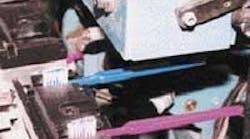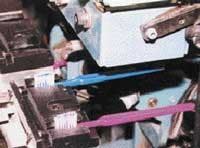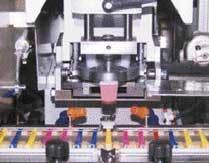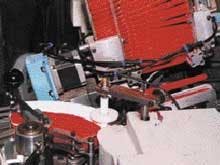by Shirley Gutkowski, RDH, BSDH
Not all technological advancements require batteries or solar cells. Manual toothbrushes are a great example of technological advancement without microchips or lithium cells. There are actually scientific differences that make the design of today's manual brush matter more than its predecessors. There are different goals in filaments, handle, and tuft designs that are supported by research, not a marketing department. The differences are geared toward dental patients — almost all of whom lack a formal dental education.
My personal philosophy has gone through a transformation. During my entire professional life, when asked about certain toothbrushes, I'd tell my patients to get whatever made them brush for two minutes. It wasn't the brush that was magic, I'd say, it was the brusher. What I discovered is that I am wrong. Ouch.
I decided to take a little trip through the world of manual toothbrushes. What started out as a day trip to a toothbrush factory turned into a look behind the scenes of toothbrush manufacturing, nylon filament production, plastic development of handles, and the research and development that goes into making a toothbrush.
Let me relate to you what I found out.
Earlier this year, I noticed there was a toothbrush factory near where I live in Wisconsin. Some toothbrushes are manufactured out of the country; Tess Corporation toothbrushes are manufactured in a small shop in Eau Claire, Wis., by one of five machines, each slightly bigger than a refrigerator.
Mary Scholze, the sales and marketing manager, talked to me about the manufacturing process. The five-stage process starts with the handle. Tess buys handles from an outfit in Minnesota; they are inventoried in boxes, color-coded, and stacked throughout the warehouse on metal shelves.
To make an actual brush, the machine operator feeds each brush handle, one by one, into a bristling machine to make over 20,000 brushes per day.
The machine pinches a number of precut nylon filaments from the bristle stock, bends the tuft in half, jams them into a precut hole in the head of the handle and staples the tuft securely into the head. The machine does this about 40 times for each brush. All brushes are made pretty much the same way — bristles stuffed into a plastic handle.
Tess brushes are designed with two different colored bristles. These bristling machines have the capacity to hold two different filaments at a time. They can be of different colors or of different diameters.
Once loaded with bristles, the toothbrush looks pretty fuzzy. The tufts have renegade filaments sticking out here and there, giving the head the appearance of a drunken barber's version of a crew cut. The trimmer is the next step on the road to your bathroom. Oscillating blades trim the too-tall filaments, making them all uniform in height.
The third step can be considered an afterthought in hygienists' minds. The bristle tips are polished, or end-rounded. The toothbrushes go through a series of rotating disk polishers before falling into a bin, a finished toothbrush. Before the 1980s, bristle end-rounding was an enhancement in finishing the bristles. Today, it is done routinely on all but the lowest end of toothbrushes. In the case of the Tess brush, it's the final manufacturing step before packaging.
The bins are taken to an adjoining climate-controlled room, where the imprinting machine is located. A machine operator places the toothbrushes one at a time onto a belt, which has a form on it to accommodate the handle dimensions exactly. The head sticks out into space as the belt takes the brush on a journey into the imprinting machine.
The machine is gigantic! The most important function is a rubber stamp that goes through three motions. It dips into the permanent ink, onto a blotter, and then onto the handle of the toothbrush. Presto, the name and address, or some other identifying mark, is imprinted onto the handle of the multi-colored toothbrush. Two little air jets pointed at the fresh ink speed drying, and the belt moves forward, replacing the imprinted handle with the next one. The finished brush is dropped into a bin at the other end of the machine.
Once the bin is full, another machine operator takes the container to a different machine, which packages the toothbrushes in individual cellophane wrappers. They are now ready to be shipped out.
Two parts of the process captured my attention. The first was the little circle of filaments packaged much like cotton rolls, the second was the amount of research and development that goes into the brushes on the market.
The filaments
My next mission was to find out more about bristles. The nylon filaments that are such an important part of the whole brush have made a lot of headway since their inception. I found out that toothbrush bristles were the first consumer use of nylon in the 1930s.
DuPont scientists invented nylon in the first half of the last century without having a specific consumer use for it. The decision to start with toothbrushes resulted in replacing natural bristles with nylon. The first enhancement of DuPont's nylon was a development that soaked up less water, helping to maintain fiber stiffness. Years later, the knife-like nylon bristle tips became routinely end-rounded, improving the comfort of the brush. One coincidence of end-rounding is the micro-texturing effect of the filament ends. The John O. Butler Company makes a special point of mentioning it in their ads.
If you ever have the inclination to look at a nylon filament, you may be shocked to realize that it is not cylindrical in shape. It could be any of a number of polygonal shapes, oval, or even twisted. Research and development between the filament manufacturers and toothbrush developers drove the evolution of these shapes.
Take the new DuPont Tynex® Brilliance™ filament, for instance. The diamond shape gives it flexibility in more than one sense of the word. The diamond shape sets it apart from other filaments because it is easier to bend in one direction than the other. It's firm in one direction and soft in the other direction.
While talking to Jim Watts of DuPont, it was difficult to pin him down on the general guidelines of filament diameter as it relates to the firmness of a bristle. In college, our instructors told us to make sure our patients use a soft brush.
As the conversation moved along, what I thought was evasiveness proved to be a complex, multifaceted answer. Stiffness can be determined by the diameter of the nylon filament, which is true. However, the shape can also give character to this feature, as can the number of filaments assigned to each tuft hole in the toothbrush handle. The tighter the packing the firmer it feels. The length of the filament also impacts firmness.
Handles
I wasn't going to examine toothbrush handles for this article at all. As so often happens with a writer's research, the more you learn, the more questions arise. The article was getting longer and longer. More and more came to light, and then fate stuck a chemical engineer in my face — not any old chemical engineer either. This lady works for Eastman in the toothbrush plastic department. She and her cohort develop raw plastic that companies such as Butler and Oral-B use to make toothbrush handles. I could not ignore this part of the toothbrush any longer.
First, let me explain why there is an entire discipline centered on toothbrush handles. It seems that mint oil is very aggressive to plastic. So chemical and plastic engineers work to find a plastic that can withstand the harsh environment consumers put it in.
A toothbrush that breaks in the consumer's mouth during regular use would be a bad dream for the toothbrush makers. A line of brushes that broke routinely with regular use would be a nightmare!
The best plastic for toothbrush handles comes from a wood pulp called Cellulosic. It's the easiest to mold, it wears well, and it's expensive. The engineers at Eastman are working with copolyesthers, the same material the two liter soda bottles are made from, to make their plastic less expensive for the toothbrush producer. In this market, every penny counts. A penny saved on the manufacturing end can translate into a profit margin able to support further research. Copolyesthers perform nearly as well as the more expensive Cellulosic. Eastman's premier product is the clear plastic in toothbrush handles.
Ann Mathis, Eastman's chemical engineer, explained the testing that goes into the plastic. They have to withstand:
• breakage
• chemical attack
• esthetic changes
• how much pressure it takes to pluck out a bristle filament
• holes drilled close together
Toothbrushes, of course, are dropped, bent, forced, bathed in home care products, heated, and, in a nutshell, treated very poorly during these tests.
When the brush makers' specifications are met, the product, in pellet form, is shipped to the manufacturing plant. The pellets are melted down and injection molded into handles.
Oh, but we aren't finished yet. Ergonomic research says that a straight, clear-blue handle isn't going to cut it in the ease-of-use category. It must be fat here and thin there to be ergonomic. It has to have a comfort rubber grip. Marketing says the brush must stand out visually somehow with two or three different colors on the handle. It must have a rubber knob on it to keep the brush head off the counter when the consumer lays it down.
The chemical engineers are back at the drawing board. It's extremely difficult to add color to clear plastic. Getting two dissimilar plastics to have flawless interfaces that perform as well as uniplastic handles is another challenge requiring a great number of college credits.
They must find a recipe for plastic that will accept the adhesive used to attach the rubber components of the toothbrush handle without becoming unsightly or weak. The number of permutations is countless. The plastic they develop must withstand the abusive chemical attacks of toothpaste ingredients such as mint, and it must withstand the abuses of consumers who think a Jack Daniel's bath is just the thing for sanitizing the bristles. When they solve one problem, another one comes along.
With all these factors of the equation, how can we steer our patients to the right brush? As hygiene professionals we must first understand what is available to our patients. Then we must find out what difficulty they are having with plaque removal in order to make the right recommendation.
During my discussions with DuPont's Watts, it became clear that there was much more to toothbrush development than the color or shape of the bristles — or, the color, angle, shape, or other innovations of the handle for that matter. My thesis became how to show that these differences in toothbrush design are not really the brainchild of a marketing department. Instead, there is real research behind them.
Toothbrush development
Think back to a time when your boss said something to a patient or a pal that made you feel like the cleaning lady. The employer's attitude diminished dental hygiene to something purely cosmetic. That's exactly how the R&D people feel in the dental home-adjunct field. They bust their humps delivering a product that dental professionals request for patients, and for what consumers say they want. Then we dental types look at the item and scoff that it's a marketing ploy. I'm here to tell you that there is serious research done to determine the size, shape, color, texture, feel, and functionality of toothbrushes.
For many people, the flat, 90-degree toothbrush is just the ticket. True odontophiles have great success in using the basic brush devoid of color and multiple angles to remove plaque. With a little more training, they can even master bristle flossing and remove a good percentage of the plaque between teeth. That's not most people, and it certainly isn't who these companies make their brushes for.
Intuition
As the manual brush evolved, certain changes were made out of intuition and others were the result of serious research. End-rounding of the filaments, or blackening them to hide blood from the user, are examples of changes from intuition. Other examples are adding antibacterial properties to the bristles, tapering the head, and the handle design that allows the bristle tips to be on the same plane as the handle, decreasing pressure on the teeth.
The Butler GUM brushes are trimmed in a way to create a dome-shaped brushing surface. The tufts down the center are taller than the outer bristles. Placing the head of the brush so that the bristles touch the tooth at any plane maintains the 45-degree angle we know and love. The shape of the bristles and the new shape of the handle assure the correct angle for the bristle to gain technique access to the sulcus.
Another Butler innovation is the coating on their Proxabrush bristles. Chlorhexidine is mixed with an acrylic and sprayed onto the bristles. The specific gravity of the CHX is lighter than the acrylic so it floats to the top, giving the bristles an antimicrobial coating that keeps them sanitized for up to two weeks.
The intuitive dome shape is still part of the brush. The newest modification is the filament used to construct the tufts. The filament, named MicroTip, becomes purposefully frayed during manufacturing. Magnified, it looks like a jester's cap, with little filament fragments blooming from the end. DuPont developed this filament for use in the Butler brushes. Each of the little fragments is about 1.5 to 2 mm long. Research indicates its superiority to other non-blooming bristle tips.
More than a little research
The development of some brushes occupied untold hours of research and study. Take the history of the Oral-B CrossAction toothbrush. It's the wildest looking brush on the shelves. The bristles are at four different angles (including the power tip), at four different lengths, and the head contains numerous different filament diameters and colors. Their years of research and many development prototypes produced what you see on the shelf today. The Oral-B goal was simple: Make a toothbrush that required nothing of the user other than putting it in the mouth and moving it, period. The company is confident they have achieved that goal.
Dentists worked side by side with the researchers. Years of conversations with oral health-care providers and consumers helped develop their entire line of toothbrushes. The consumers were regular folks who did not spend an entire semester working out the intricacies of the Modified Bass technique, and how it differs from Bass and Fones methods. Their input was very important to the development of the CrossAction brush.
Concurrently, a team works in the lab. They know that there are two places critical for plaque removal — the proximal surfaces and the sulcus. A technique-free brush is one that will remove plaque from those two key areas. The team mounts a tiny camera between the teeth in a couple of typodonts and begins dragging filaments of different types at different angles across the teeth in a manner notorious of regular brushers. They record the way each whips into or past the embrasures. They note whether it reaches the proximal surface at all, or skips to the next convex-most portion of the adjacent tooth.
Once they have a working prototype, the research continues with focus groups of regular tooth brushers. With the information gathered, they continually modify the prototypes until everyone is happy. The final step is to publish the findings of their research in peer reviewed journals.
This process reflects a life's work. Researchers feel good about what they do, the same way we feel good about what we do. They support us in our goals for patient's health.
Oral-B has also done some important research in children's brushes. Almost all manufacturers produce brushes aimed at children of various ages. They scale down their adult brushes, use kid-friendly characters and colors, and then call them brushes for children. With the help of focus groups comprised of parents, kids, pediatric dentists, and child development specialists, Oral-B has come out with a revolutionary concept: Make a brush to address all stages of oral development.
The Stages series of brushes are something else entirely different from the scaled-down versions of adult brushes. On a recent fact-finding mission at a local store, I looked at a Gerber infant's toothbrush for comparison. The Gerber handle was too short for a mother's hand and too narrow for an infant's. The head, while narrow, was very long. I kept imagining the sound of a gagging child, and the watery little eyes as a reflex of the surprise tonsil tickle. The infant brush by Oral-B is made for a mother's hand (or dad, grandma, uncle, etc.). It's long enough to fit an adult palm; wide enough for an infant to grasp. The colors of the infant brush are muted and the Oral B trademark indicator bristles are present.
Imagine brushing a child's teeth for them. They bite down on the brush all the time. The researchers noticed as well. So, they put a little rubber end on their brushes to protect the gingival tissue from the hard plastic. There are other differences too. The brush intended for kids with mixed dentition, takes into effect the gaping spaces between the time a tooth is lost and another erupts. The point is that some marketing maven in a corner office on the 109th floor did not think them up. The designs of these advanced brushes did not come from an artist's mind. They developed and grew out of hard and soft research. So did the filaments for the bristles and, yes, even the colors and handle designs.
All of this research and manufacturing is done without oversight by a governmental body. The companies that make money, do it with their own guidelines for safety and product performance. If the product doesn't perform by looking pretty, or keeping its bristles for longer than the recommended life span of a brush, manufacturers don't make it. Or, they may make it for a region that has different standards than we do here in this great nation.
The superiority of powered brushes over their manual forefathers is genuine. We see the difference in our patients clinically. Even tested against the newer manual brushes, the high-end power brushes come out ahead. However, in the research done by Oral-B on the CrossAction brush, they find it is superior in plaque removal to the low-cost battery brushes.
So, while the regular flat, end-rounded bristle, unfancy toothbrush is adequate for hygienists, it may not be for our patients. It could be that their thoughts are someplace else while they brush. It could be that they don't have a brain cell to devote to proper technique. Maybe they're just lazy.
The facts are that toothbrush technology is supporting us in the plaque removal goals we have for our patients and our goal of creating healthy patients.
Shirley Gutkowski, RDH, BSDH, has been a full time practicing dental hygienist in Madison, Wis., since 1986. Ms. Gutkowski is widely published in print and on Internet sites, and speaks to groups through Cross Links Presentations. She can be contacted at [email protected].









